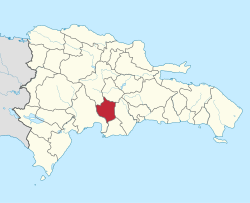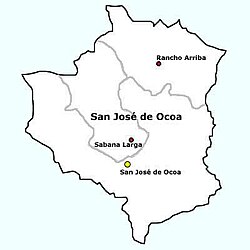San José de Ocoa Province
San José de Ocoa | |
|---|---|
 View of San Jose de Ocoa capital town with Sierra de Ocoa mountain range in the background | |
 Location of the San José de Ocoa Province | |
| Coordinates: 18°32′38″N 70°30′28″W / 18.54389°N 70.50778°W | |
| Country | |
| Province since | 2000 |
| Capital | San José de Ocoa |
| Government | |
| • Type | Subdivisions |
| • Body | 3 municipalities 3 municipal districts |
| • Congresspersons | 1 Senator 2 Deputies |
| Area | |
| • Total | 855.40 km2 (330.27 sq mi) |
| Time zone | UTC-4 (AST) |
| Area code | 1-809 1-829 1-849 |
| ISO 3166-2 | DO-31 |
| Postal Code | 93000 |
San José de Ocoa is a Dominican province; it is on the southern side of the Cordillera Central ("Central mountain range"). Its capital has the same name, San José de Ocoa.
Name
[change | change source]The province is named after its capital city, San José de Ocoa. Ocoa is the name of the river that crosses the province; it is a Taíno word that means "a place with many mountains".[1]
History
[change | change source]Bartolomé de Las Casas was the first person that wrote about the region when he said that Maniey (now, Maniel) was a Taíno province.[2] Maniey or Maniel meant "a place where there are peanuts";[3] mani (Spanish: maní) is the Taíno word for peanut. Peter Martyr d'Anghiera did not write about the Maniey but he wrote about a lake in the region of Rancho Arriba;[4] there is not a lake (or lakes) there anymore, only a swamp.
For a long time, the region was visited only by monteros (men that hunted wild cows and pigs). Then some maroons (runaway slaves) came to live here, in the high mountains of the region. One settlement was called Maniel; since then, Maniel meant in Hispaniola a place where maroons live and not only the name of the region.
The first settlement by maroons in the region is from the beginning of the 16th century and was called Maniel Viejo de Ocoa.[5] This settlement lasted until 1666 or 1667 because many people died from smallpox and measles that affected the island in those years. There was also a military action in the region to capture maroons.
The second settlement was during the first years of the 19th century (around 1802), and it is known as Maniel de los Lorenzos ("Lorenzos' Maniel") because of the last name ("Lorenzo") of its founders. It was founded at El Canal, north of the city of San José de Ocoa.[5]
Very soon some families from Baní, on the south, began to move to the region and made their houses at what is now the city of San José de Ocoa.[5]
During the Dominican War of Independence (1844), there were two important battles in the region: the battles of El Memiso and of El Pinar, won by Dominican soldiers. So the Haitian soldiers could not go on to Santo Domingo, and had to go back to Haiti.
In December 1858, San José de Ocoa was made a municipality of the old province of Santo Domingo; in 1895, it was changed to a municipality of the Azua province. With the creation of the Peravia, San José de Ocoa was a municipality of that new province. Then, on 6 September 2000, San José de Ocoa was made a new province with the northern half of the Peravia province and with the municipalities of San José de Ocoa, Rancho Arriba and Sabana Larga, and the municipal district of La Ciénaga.[6]
In 2004, Nizao-Las Auyamas and El Pinar became municipal districts, and El Naranjal in 2006.[6]
Location
[change | change source]San José de Ocoa is bordered to the north by the Monseñor Nouel and La Vega provinces, to the east by San Cristóbal, to the south by the Peravia, and to the west by Azua.
Population
[change | change source]In 2014 (last national census), there were 97,640 people living in the San José de Ocoa province, and 37,466 (38.4%) living in towns and cities. The population density was 114.4 persons/km².[7]
Its population represents 1.03% of the total population of the country and the province is ranked as the 29th (out of 31 plus the National District) more populated province.
As of 2016[update], the total estimated propulation of the province is 56,565 inhabitants.[8]
The largest city of the province is San José de Ocoa, its head municipality or capital, with an urban population (in 2014) of 22,383 inhabitants.[7]
Geography
[change | change source]The San José de Ocoa province has a total area of 853.4 km2 (329.5 sq mi).[7] It has 1.8% of the area of the Dominican Republic and it is ranked as the 26th (out of 31 plus the National District) largest province.
The altitude of the provincial capital, San José de Ocoa, is 513 m (1,683 ft) above sea level.[9]
The most important river is the Ocoa river, that flows through the province from north to south.
Municipalities
[change | change source]There are 3 municipalities and 4 municipal districts (M.D.) in the province.[6]

| Municipality (code) |
Municipal Districts (code) | Population (2010) |
Area (km2) |
Density | Altitude (m) |
|---|---|---|---|---|---|
| San José de Ocoa (310101) | 25,710 | 82.4 | 312.0 | 513 | |
| La Ciénaga (310102) | 4,128 | 126.5 | 32.6 | 739 | |
| Nizao - Las Auyamas (310103) | 2,791 | 92.7 | 30.1 | 589 | |
| El Pinar (310104) | 3,736 | 154.7 | 24.1 | 638 | |
| El Naranjal (310105) | 3,086 | 28.5 | 108.3 | 661 | |
| San José de Ocoa (310100) | 39,451 | 484.8 | 81.4 | ||
| Sabana Larga (310201) | 9,794 | 163.6 | 59.9 | 623 | |
| Sabana Larga (310200) | 9,794 | 163.6 | 59.9 | ||
| Rancho Arriba (310301) | 10,299 | 205.0 | 50.2 | 687 | |
| Rancho Arriba (310300) | 10,299 | 205.0 | 50.2 | ||
| San José de Ocoa (310000) | 97,640 | 853.4 | 114.4 | ||
Economy
[change | change source]The main economic activity of the province is farming; the main products are coffee, beans and potatoes. Other vegetables, such as cabbage and carrots, are also grown as well as some tropical fruits (avocado and mango).
References
[change | change source]- ↑ Rodríguez, Cayetano Armando (1976). Geografía de la Isla de Santo Domingo y Reseña de las Demás Antillas, Second Edition (in Spanish). Santo Domingo: Sociedad Dominicana de Geografía, Vol. XI. p. 399.
- ↑ Las Casas, Fray Bartolomé de (1966). Apologética Histórica Sumaria. Tomo I, Capítulo VII (in Spanish). México: UNAM.
- ↑ Vega, Bernardo (1989). Los Cacicazgos de la Hispaniola (in Spanish). Santo Domingo, Dominican Republic: Museo del Hombre Dominicano.
- ↑ Anglería, Pedro Mártir de (1949). Décadas del Nuevo Mundo, Tercera Década, Libro VII (in Spanish). Buenos Aires: Editorial Bajel.
- ↑ 5.0 5.1 5.2 Read, Alexis (1993). Apuntes para una Historia de los orígenes de San José de Ocoa (in Spanish). San José de Ocoa: ADESJO, Ediciones Convite.
- ↑ 6.0 6.1 6.2 "División Territorial 2015" (in Spanish). Oficina Nacional de Estadística (ONE). October 2015. Archived from the original (PDF) on 14 November 2015. Retrieved 26 November 2016.
- ↑ 7.0 7.1 7.2 Consejo Nacional de Población y Familia. "Estamaciones y Proyecciones de la Población Dominicana por Regiones, Provincias, Municipios y Distritos Municipales, 2014" (PDF) (in Spanish). Retrieved 2014-02-02.
- ↑ "REPÚBLICA DOMINICANA: Población por año calendario, según sexo y grupos quinquenales de edad, 2015-2020" (in Spanish). Oficina Nacional de Estadística (ONE). Archived from the original (XLS) on 24 June 2016. Retrieved 26 November 2016.
- ↑ "San José de Ocoa". Geonames.org. Retrieved 26 November 2016.

